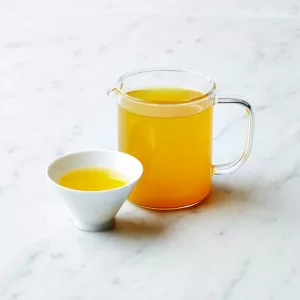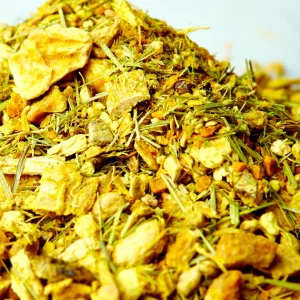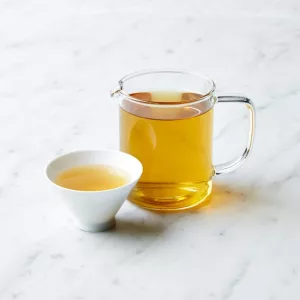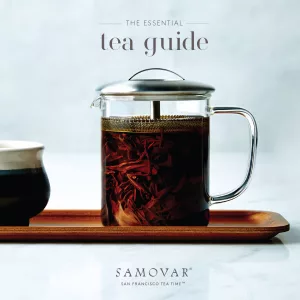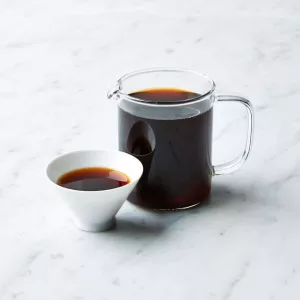Oolong tea can be dangerous. Lilies explode in full bloom… Autumn leaves fall in the woods… Tree-ripened peach juice drips down your chin… The aromas and flavors weave together in beguiling combination. An experience with oolong lingers in your memory like a lover’s kiss.
In the hands of artisans-of-the-leaf, oolong will spoil you thoroughly. Thousand year-old tea cultivars grown in the cliffs of Southern China and Taiwan develop character that can only come from facing challenges and overcoming.
To drink these oolongs is to erase memories of tea past and to leave in their place a new ideal by which you will measure all future tea.
I drink a variety of oolongs, typically brewed in, and sipped from, a gaiwan. But over the holidays I bring out my top-shelf oolongs.
Oolong pairs exceptionally well with Thanksgiving turkey, wild salmon and most meats. Like fine varietal wine, oolong has terroir. Flavor characteristics come from the unique way it is processed and also genetic traits interacting with the climate, geology, and geography of the land where it was cultivated.
Oolong can sit at the table proud of its contribution to your holiday feast.
But how do you select a good oolong? And how do you incorporate it into your meal? Here’s a guide to help you on your oolong journey. (Plus, read on to learn about a pair of rare oolongs that we just sourced — in limited supply.)
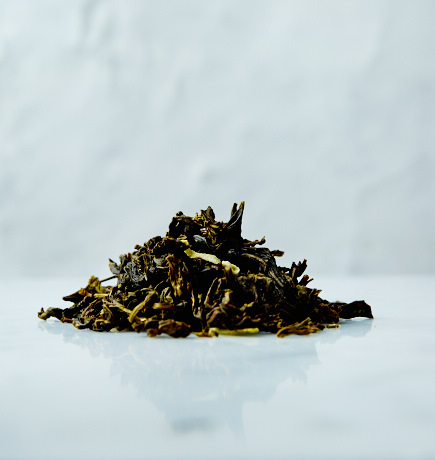
Four Essential Characteristics
Even before you taste tea, you can judge its quality simply by looking at four characteristics.
1. SIZE — When you examine the leaves how much does the size vary? Are some leaves big and others small? Choose tea with consistent size.
2. SHAPE — Tea masters traditionally roll or twist oolongs to seal in flavor and aroma. If it’s rolled it should be a tight ball about 1/4” in diameter. If twisted it should be long and slender. Each leaf should be consistent with the others.
3. COLOR — Black, brown, green, red, purple, the color reflects the genetic heritage, how it was grown, when it was picked, and the specific production process. How much does the color vary from leaf to leaf? Choose tea with consistent color.
Why the emphasis on consistency? To make an oolong, each tea master follows his own proprietary process. Details vary depending on the goal for the tea but generally involve: picking the right leaves (size, shape, color), sun wilting, tossing in baskets, bruising and macerating, baking, roasting or frying, rolling or twisting, drying, and sometimes firing again.
If leaves are not consistent, the processing will act differently on each leaf. For some it will be too much, for others not enough. In the teapot, some leaves will underbrew and others will overbrew creating a murky, flabby flavor.
Consistency is rare because it is hard to achieve. Leaves can’t just be mindlessly grabbed from the tree. Picking the right leaves takes eyes, details, and a sensitive hand. Getting a consistent roll and twist takes time.
And yet, it is consistent leaves that yield a nuanced, complex flavor. Each leaf is an instrument in lyric performance. Tea of consistent size, shape and color harmonizes to amplify the aroma and flavor notes producing a clear, balanced, memorable tea.
4. AROMA — Quality oolong gives off a complex aroma before you even brew it. When you open the package how does it smell? Choose tea with pronounced aroma. No aroma? The tea is old or stale from poor handling.
Oolong At The Table
Oolong done right can be a feature of your meal.
Choose the tea
Apple Gingseng makes a fantastic entry into the world of Oolongs. Particularly in late fall or winter where a warming, lingering taste of nature is a wonderful thing. Oolong at it’s best can be found with Golden Phoenix – a vivid flavor of fresh fruit and honey. These can be found in our Oolong Collection.

Awaken
Choose your brewing vessel: Cloud Gaiwan, Vivid Brewpot, or classic Samovar Teapot.
Pre-heat the vessel with a quick rinse of hot or boiling water.
Add leaves. How much? Our rule of thumb: more tea, less time. 1 tablespoon of tea is good for a gaiwan. For larger pots add slightly more tea.
Smell the aroma of unbrewed tea in your brewing vessel. Pass it around. Appreciate the size, shape, color.
Add water at just below boiling temperature, 190 to 200 (f). If you don’t have a thermometer, bring water to a boil and let it sit for about a few seconds..
The first infusion is a rinse. Don’t drink it, just pour it down the sink. We call this “awakening the leaves.”
Expert tip: Awakening the leaves allows the tea to quickly release their complex flavors. However, some oolongs, such as Dancongs, don’t need to be rinsed since they may lose some of their delicate aroma.
Inhale
Gaiwans are designed to concentrate the flavor and aroma of the tea, but most teapots will do.
Exhale, crack the lid of your gaiwan just enough to let your nose in, inhale. Return the lid while you hold your breath to let the aroma permeate nasal cavity and head. Pass the brewing vessel to the next guest.
What do you smell? Close your eyes. What do you see?
Brew
Add more water, steep for 30 seconds. Increase time for each subsequent infusion in order to extract more flavor.
Pour
Oolong loves small 3-4 ounce tasting cups. Line up all your cups as closely as possible.
Hold your gaiwan or teapot close to the lip of the cup and fill each one third of the way. Repeat the process filling the next third. Finally, top off with the last third jerking slightly to extract every last drip.
Oolong is not served like wine, filling each glass fully before moving on to the next. Filling by thirds creates a balanced cup with liqueur (infused tea) from the top, middle, and bottom of your brewing vessel.
Expert tips
Keep the lid on your teapot to preserve the aroma.
If you brew in a gaiwan, you might want to have a couple cups on hand. One of our gaiwans can usually fill 2-3 tasting cups.
Look
While the tea cools, look at the color. Try to remember the color because it will change with each subsequent infusion.
Expert tip: Look for three layers: bottom color, middle color, and top color.
Sip
Please slurp! Mixing more air with the liqueur releases more flavor. Swish. Try to notice three phases of flavor: the initial hit, the primary flavor, and the lingering aftertaste.
Close your eyes again. What do you taste? What visions come to mind?
Also consider the tea’s body, called the mouthfeel. Is it stout and robust? Silky smooth?
Expert tip: Taste your tea at different temperatures: boiling hot, warm, and cold. Good tea has excellent flavor and body at any temperature. Professional tea tasters will use boiling water and steep for minutes until the tea becomes very astringent so they can see the qualities of the tea at maximum potency.
If you’re having trouble describing the aroma or flavor, here’s a bit of tea vocabulary to help you find your tasting voice.
VEGETAL — barnyard, fresh cut grass, straw, spinach, sugar snap peas, fennel, eucalyptus, thyme.
FLORAL — rose, orchid, lily, honeysuckle, cherry blossom
NUTTY — almond, walnut, chestnut, roasted peanut, pine nuts
SWEET — stewed prunes, honey, burnt sugar, maple syrup
TOASTED — pipe smoke, burnt wood, barbecue
SPICY — cinnamon, pepper, clove, cocoa
FRUITY — pineapple, banana, mango, green apple, peach, blackberry, strawberry
EARTHY — ocean air, wet rocks, forest floor, worn leather, moss, cherry wood, oak wood, cedar, pine
Repeat
With each infusion the character of the tea will evolve. The third infusion is often the best. Great oolong is said to have patience, the ability deliver aroma and flavor for 15 or more infusions.
Expert tips
Always pour for others first.
To say thank you, lightly tap two fingers on the table after your host has filled your cup.
Going solo? The gaiwan can be used as a drinking and brewing vessel. Steep, and when ready, tilt the lid slightly so that it strains the leaves while you sip the tea.
In addition to tasting great, the health benefits of tea continue to show up in modern scientific research. I’m no doctor, and this is not medical advice, but here are a few of the potential benefits found in recent studies:
Oolong tea increases metabolism, aids in fat absorption, and makes weight loss easier.1, 2, 3
Caffeine tends to reduce bone mineral density (BMD) in women, but drinking tea actually increases BMD .4, 5
Three cups of tea daily has been linked to lower risk of stroke.6
Drinking tea has been linked to better brain function at older ages.7
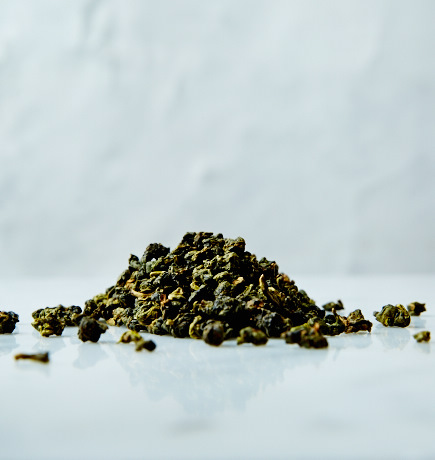
Explore Our Oolong Collection >

